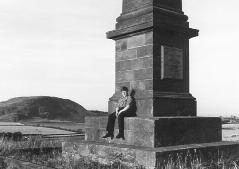
From the age of six (1960) I lived in a council house in the village of Morham, went to the local primary school there and later to the Knox Academy in Haddington.
Primary school had one teacher for all classes P1-P7, and later on in life I realised how biased and unfair this system was. School holidays were taken at times that coincided with local farming practices that allowed you to get work, ie tattie picking, stacking bales and picking berries (strawbs or rasps at Letham Mains, Haddington).
There were school outings organised and most years we would get a visit from the local traffic police and be given instruction on road safety. They would come – two police constables, one woman police constable and a policeman on a motorbike – complete with rolled up zebra crossing and portable Belisha beacons. I recall the panic when a lorry came along, and the zebra crossing was hastily rolled up!
Bus services were limited and it was essential to have an independent means of transport and for me that meant first of all a push-bike at age seven, and later a motor-bike at 16. My father being (at this time) a lorry driver, brought home some gob stopper sweets from the post office at Cranshaws. These were huge (about golf ball size) and popular with us kids, so a cycle run was undertaken by five of us to cycle to Cranshaws and bring back a supply for ourselves and any others who could not go on such a long journey. It took us the best part of a Saturday for our jaunt and was probably a 20-25 mile round trip. I think this was done three or four times before the shop stopped stocking that particular sweet.
Travelling to the Knox on the school bus introduced me to new friends and classmates, so then cycling to other villages (Garvald and Gifford) and farms outside Morham parish allowed greater freedom, and a chance to become more independent. This was gradually expanded when at 16 I got my first motor-bike and discovered others who had motor-bikes. Some were known to me through school, the others were new friends with a common interest.

The cycle runs of my earlier years now turned into evening and weekend runs on the motor-bikes, and naturally we found the limits of our own abilities (bumped heads – no helmets required, torn jeans, gravel rash, and the wet and cold – wet weather gear was usually inadequate) and the limits of our chosen machines – roadside repairs and a comprehensive tool kit were compulsory it seemed. Nowhere was safe, all roads in and around East Lothian were explored, as were any tracks leading off into either the hills or on the coastal margins. Although no malice was intended, this was sometimes not the view taken by others, and required us as a group or individually to ‘bugger off’ as was advised.
Socially, in the autumn, in Morham Hall there was indoor carpet bowling; the East Lothian League required the club to turn out to other parishes – Garvald, Longyester, Spott, the Boggs. Then there were the kirns (basically Scottish country dancing) held to boost hall funds, and at Garvald on a Saturday night there was also a dance held. There were other kirns held at Longyester, Crossroads, Boggs; some of these died out, others turned into flower show dances.

Being now an older teenager and having a job, my own transport and new friends, my social life started to drift away from the traditional country style, and more trendy venues were sought; youth club discos turned into a regular hunt for new adventures. Held at the likes of Haddington Corn Exchange, the Victoria Ballroom Dunbar, and Haggerston, Eyemouth and Duns. Eventually my group of friends found the Pavilion at North Berwick a particular favourite, and some of my friends went on to marry North Berwick girls, and some live there still.
Morham parish has been quite fortunate in that there has not been the property available for development, and so there has not been a huge influx of incomers, although some consider the boundary walls of the old school playground to be another separate village’.
Robert Gray served his apprenticeship with Drew Harrower at Whittingehame smithy; having spent some years in the construction industry, he now works mostly on agricultural repairs in the county, and runs the construction side of a landscaping business with his partner, Sonia Baker (the East Lothian Fourth Statistical Account editor).